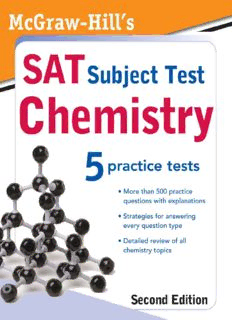
McGraw-Hill's SAT Subject Test: Chemistry, 2ed PDF
Preview McGraw-Hill's SAT Subject Test: Chemistry, 2ed
THE TOP 40 THINGS YOU NEED TO KNOW FOR TOP SCORES IN CHEMISTRY 1. CHANGES Understand and be able to identify the difference between physical and chemical changes. See Chapter 1. 2. REACTIONS Understand and be able to identify the difference between exothermic and endothermic reactions. See Chapter 1. 3. MIXTURES Know the differences between substances, mixtures, and the components of mixtures. See Chapter 1. 4. GAS LAWS AND CALCULATIONS Be able to use the gas laws to calculate moles, pressure, volume, and mass of a sample of gas at various temperatures and conditions. See Chapter 2. 5. MATTER Be able to name the changes in phases of matter and identify them on a heating/ cooling curve. See Chapter 2. 6. SUBATOMIC PARTICLES Understand the properties of the subatomic particles and how they allow iso- topes to exist. See Chapter 3. 7. ELECTRON CONFIGURATION Be able to provide the electron configuration of an element given the num- ber of electrons. See Chapter 3. 8. MOLECULES Know how to distinguish between the various hybridization states and the shapes of molecules that can be formed. See Chapter 3. 9. THE OCTET RULE Understand the octet rule and how it allows atoms and ions to be stable. See Chapter 3. 10. GROUPING AND THE PERIODIC TABLE Know the properties and names of various groups/families within the peri- odic table. See Chapter 4. 11. METALS, NONMETALS, AND THE PERIODIC TABLE Know the properties and locations of the metals and nonmetals. See Chapter 4. 12. TRENDS AND THE PERIODIC TABLE Know the trends for electronegativity, ionization energy, and atomic radius across the periodic table. See Chapter 4. 13. BONDS Be able to distinguish between the various intramolecular bonds: covalent (polar vs. nonpolar), ionic, network covalent, hydrogen, coordinate covalent, metallic, dispersion/Van der Waals, and molecule-ion attraction. See Chapter 5. 14. SIGMA AND PI BONDS Be able to tell the difference between sigma and pi bonds and be able to locate them within a molecule. See Chapter 5. 15. COMPOUNDS Be able to name ionic and covalent compounds using both traditional methods and the stock method. See Chapter 5. 16. CHEMICAL EQUATIONS Know how to balance and classify chemical equations. See Chapter 6. 17. CALCULATIONS OF COMPOUNDS Be able to calculate percent hydration and percent composition of a compound. See Chapter 6. 18. SOLUBILITY RULES Understand how to use solubility rules to predict the products of a reaction and write net ionic equations. See Chapter 6. 19. SOLUTIONS Know how to calculate the concentration of a solution. See Chapter 6. 20. THE MOLE Understand how to use the mole to calculate the number of liters a gas will occupy, the number of molecules present, the mass of a sample, and the num- ber of moles of another substance in a reaction. See Chapter 6. 21. POTENTIAL ENERGY DIAGRAMS Be able to draw and label a potential energy diagram. See Chapter 7. 22. HEAT Know how to use a potential energy diagram and Hess’s Law to calculate heat involved in reactions. See Chapter 7. 23. RATE OF REACTION Be able to determine how to change the rate of reaction. See Chapter 8. 24. EQUILIBRIUM Be able to determine how changing conditions changes the point of equilib- rium of a reaction. See Chapter 8. 25. PRODUCTS AND REACTANTS Understand how to use K and K values to find concentrations of products eq sp and reactants. See Chapter 8. 26. SPONTANEOUS REACTIONS Know how to determine if a reaction will be spontaneous. See Chapter 8. 27. ACIDS AND BASES Understand the various operational and conceptual methods for defining acids and bases. See Chapter 9. 28. K a Understand what K can tell us about an acid or a base. a See Chapter 9. 29. MOLARITY AND pH Know how to calculate the molarity and pHof an acid or a base solution. See Chapter 9. 30. OXIDATION NUMBERS Be able to determine the oxidation numbers for the elements in a compound. See Chapter 10. 31. OXIDIZING AND REDUCING AGENTS Know how to identify the substances that had a change in oxidation num- ber and identify which serve as an oxidizing or a reducing agent in a half- reaction. See Chapter 10. 32. REDOX REACTIONS Be able to balance both simple and complex redox reactions. See Chapter 10. 33. VOLTAIC AND ELECTROLYTIC CELLS Know how to determine the reactions that occur within voltaic and electrolytic cells. See Chapter 10. 34. PREFIXES Understand the prefixes used in organic chemistry so as to know the number of carbon atoms present in a molecule. See Chapter 11. 35. FUNCTIONAL GROUPS IN ORGANIC CHEMISTRY Be able to distinguish between the various functional groups in organic chemistry which contain oxygen, nitrogen, and double and triple bonds. See Chapter 11. 36. RADIATION Be able to identify the risks and benefits of using radiation. See Chapter 12. 37. NUCLEAR EMANATIONS Know the differences between various types of nuclear emanations. See Chapter 12. 38. HALF-LIFE AND MASS CALCULATIONS Be able to calculate the half-life of an isotope or the mass of a radioactive sample after a certain period of time. See Chapter 12. 39. LABORATORY TECHNIQUES Understand safe and general laboratory techniques. See Chapter 13. 40. LABORATORY CALCULATIONS Know how to make all necessary calculations pertaining to experiments car- ried out in the laboratory. See Chapter 13. This page intentionally left blank McGRAW-HILL’s SAT SUBJECT TEST CHEMISTRY This page intentionally left blank McGRAW-HILL’s SAT SUBJECT TEST CHEMISTRY Second Edition Thomas A. Evangelist Assistant Principal, Supervision of Science New York City Department of Education New York / Chicago / San Francisco / Lisbon / London / Madrid / Mexico City Milan / New Delhi / San Juan / Seoul / Singapore / Sydney / Toronto
